Urban Centre design and energy management
Added on 2022-10-17
49 Pages4613 Words60 Views
Nasr Tayeh
18021022
300798
Table of Contents
Abstract................................................................................................................. 1
Introduction........................................................................................................... 2
The Effects of Built Environment........................................................................... 3
The sub catchment contour lines are 40 on each side terrain view of the selected area.
Therefore , the selected area is very good for building..................................................11
Number of residential and commercial buildings in urban centre.......................11
Typical residential house design satisfying BASIX...............................................12
Overall energy to sustain the urban centre over 50 years lifecycle.....................13
Total runoff using MUSIC..................................................................................... 13
WSUD technologies to be adopted for urban area...............................................14
Embodied energy for a typical residential and commercial properties using GaBi
............................................................................................................................ 16
Operational energy in urban centre.....................................................................37
Operational energy residential houses/ buildings.............................................37
Operational energy for commercial buildings...................................................37
Total energy in urban centre............................................................................37
Total energy to sustain the urban centre over 50 years......................................38
Develop a water balance for the urban area.......................................................38
Report summary.................................................................................................. 38
Conclusions.......................................................................................................... 40
Appendix.............................................................................................................. 41
References........................................................................................................... 46
Page | 1
18021022
300798
Table of Contents
Abstract................................................................................................................. 1
Introduction........................................................................................................... 2
The Effects of Built Environment........................................................................... 3
The sub catchment contour lines are 40 on each side terrain view of the selected area.
Therefore , the selected area is very good for building..................................................11
Number of residential and commercial buildings in urban centre.......................11
Typical residential house design satisfying BASIX...............................................12
Overall energy to sustain the urban centre over 50 years lifecycle.....................13
Total runoff using MUSIC..................................................................................... 13
WSUD technologies to be adopted for urban area...............................................14
Embodied energy for a typical residential and commercial properties using GaBi
............................................................................................................................ 16
Operational energy in urban centre.....................................................................37
Operational energy residential houses/ buildings.............................................37
Operational energy for commercial buildings...................................................37
Total energy in urban centre............................................................................37
Total energy to sustain the urban centre over 50 years......................................38
Develop a water balance for the urban area.......................................................38
Report summary.................................................................................................. 38
Conclusions.......................................................................................................... 40
Appendix.............................................................................................................. 41
References........................................................................................................... 46
Page | 1

Nasr Tayeh
18021022
300798
Abstract
The practice of extraction of the natural resources and the impact of
industrialisation during past years within the two centuries has resulted in
the state of global warming, which also reflects to the causes such as
combustion of fossil fuels leading to the release of harmful gases in
atmosphere, thereby resulting in environment damage. Weather patterns
are changing due to the concern of Climate change, leading to the
elevation of droughts and floods in all across the globe. The recognition
and acceptability of the disastrous situations globally has only been
evident in the past decade.
The key sources of energy usage for Australia are natural gas, various oil-
based products and coal. The dependency is economically beneficial due
to the presence of natural gas, coal and petroleum reserves in the country
and along with the national consumption; Australia also exports the
resources to other countries. The main concern of Australia is that the
practice of burning coal for the purpose of generating electricity leads to
the release of greenhouse gases.
Moreover, the first world nations have recognized the future need of using
the natural resources as the main source of energy and have started
investing in innovative technologies. In Australia, Federal Government
lacks the acknowledgment of the significance of investing in the potential
of sustainable energy sources such as high capacity lines of electricity.
In 21st century the most challenging concerns in urban layout will be water
sensitivity management and the need of minimizing the overall emissions.
During the past decades, the most dreadful challenges recognized are
waste wastewater treatment concerns, awareness and acceptance
towards the significance of conservation and preserving the provision for
fresh water. The environmental quality and water supply get affected by
the shifting of global temperature into precipitation and increasing rate of
urban population. The outcome of this state signifies the importance of
effectively distributing, utilizing and disposing water. It has become
significant to execute new procedures for adapting with new realities and
changes. According to Brown (2005), Due to environmental and social
pressures stemming from the impacts of urbanisation, over consumption,
industrialisation, land clearing and other anthropogenic activities, is now
widely accepted that a new paradigm in urban water management must
be found in order to convert to the more sustainable use and
management of urban water in general and urban stormwater in
particular”. In past two eras, the perspective of Australia has been shifted
by recognizing the value of water and by acknowledging the concerns
related to quantity and quality of water. For the purpose of maintaining
water supply and quality of water, the water sensitive urban design
structures and systems needs advancement. This is only possible with the
Page | 2
18021022
300798
Abstract
The practice of extraction of the natural resources and the impact of
industrialisation during past years within the two centuries has resulted in
the state of global warming, which also reflects to the causes such as
combustion of fossil fuels leading to the release of harmful gases in
atmosphere, thereby resulting in environment damage. Weather patterns
are changing due to the concern of Climate change, leading to the
elevation of droughts and floods in all across the globe. The recognition
and acceptability of the disastrous situations globally has only been
evident in the past decade.
The key sources of energy usage for Australia are natural gas, various oil-
based products and coal. The dependency is economically beneficial due
to the presence of natural gas, coal and petroleum reserves in the country
and along with the national consumption; Australia also exports the
resources to other countries. The main concern of Australia is that the
practice of burning coal for the purpose of generating electricity leads to
the release of greenhouse gases.
Moreover, the first world nations have recognized the future need of using
the natural resources as the main source of energy and have started
investing in innovative technologies. In Australia, Federal Government
lacks the acknowledgment of the significance of investing in the potential
of sustainable energy sources such as high capacity lines of electricity.
In 21st century the most challenging concerns in urban layout will be water
sensitivity management and the need of minimizing the overall emissions.
During the past decades, the most dreadful challenges recognized are
waste wastewater treatment concerns, awareness and acceptance
towards the significance of conservation and preserving the provision for
fresh water. The environmental quality and water supply get affected by
the shifting of global temperature into precipitation and increasing rate of
urban population. The outcome of this state signifies the importance of
effectively distributing, utilizing and disposing water. It has become
significant to execute new procedures for adapting with new realities and
changes. According to Brown (2005), Due to environmental and social
pressures stemming from the impacts of urbanisation, over consumption,
industrialisation, land clearing and other anthropogenic activities, is now
widely accepted that a new paradigm in urban water management must
be found in order to convert to the more sustainable use and
management of urban water in general and urban stormwater in
particular”. In past two eras, the perspective of Australia has been shifted
by recognizing the value of water and by acknowledging the concerns
related to quantity and quality of water. For the purpose of maintaining
water supply and quality of water, the water sensitive urban design
structures and systems needs advancement. This is only possible with the
Page | 2
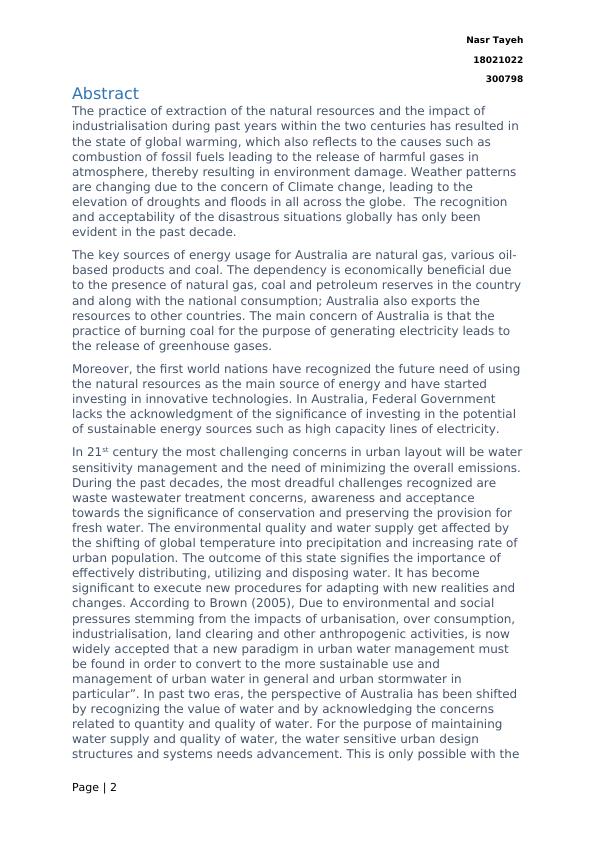
Nasr Tayeh
18021022
300798
collaborative perspective of the state and federal government recognizing
the concerns and taking initiative of saving the storm water for the source
of water supply rather than perceiving as an environmental burden.
Introduction
In the past course of three eras, Australia has experienced the constant
increase of urban population, the progressing decision of clearing land for
the new construction plans and the increased frequency of droughts, fires,
storms and floods due to changing patterns of weather in all across
Australia. These evidences in Australia reflect the importance of changing
the approach of water sensitive urban design for managing the supply of
water supply for addressing the increasing demand. The country also
reflects the need for improving the quality management of urban water
practices for protecting the health of available water. Storm water should
not only be considered as environmental risk rather should also be valued
as major source of water supply, which requires infrastructure and
mechanism system for treating the storm water as the source of water
supply. According to the Australian Prime Ministers Science, Engineering
and Innovation Council (2007), the country should have varied portfolio
regarding water supply choices. Thus, the storm water needs to be used
as one of the primary source of water supply for beneficial use rather than
treating it as wastewater.
The Environmental Science and Policy of January 2017, Volume 25, page
number 62-72 reflected a quote under the subtitle Configuring
Transformative Governance to Enhance Resilient Urban Water Systems
that, “Governance reforms are required to establish adaptive and resilient
urban water resource management that takes into account completely,
uncertainly and immediate and long term change” (Rijke, J, Farrelly, M,
R.Brown & Zevenbergen, C). This quote depicts the actual state of water
structure of Australia that marks the importance of recognizing the
present and structuring system for future by the government. The
Ecological Sustainable Development of Australia is about preserving and
safeguarding natural resources like coastal waters, water supply
catchments and waterways rather than shielding the environment from
effects of pollution. In Australia, the Water Sensitive Urban Design
requires to offer sustainable urban water management for sustaining in
the water management of urban areas for the purpose of dealing with
increasing developments of urban buildings and considering the need for
looking after the urban water cycles and landscape.
In this paper, the case study on urban area of Australia will be studied for
understanding and establishing operational alignment required for
maintaining the area of 50 years life cycle by using GABI. Music is
Page | 3
18021022
300798
collaborative perspective of the state and federal government recognizing
the concerns and taking initiative of saving the storm water for the source
of water supply rather than perceiving as an environmental burden.
Introduction
In the past course of three eras, Australia has experienced the constant
increase of urban population, the progressing decision of clearing land for
the new construction plans and the increased frequency of droughts, fires,
storms and floods due to changing patterns of weather in all across
Australia. These evidences in Australia reflect the importance of changing
the approach of water sensitive urban design for managing the supply of
water supply for addressing the increasing demand. The country also
reflects the need for improving the quality management of urban water
practices for protecting the health of available water. Storm water should
not only be considered as environmental risk rather should also be valued
as major source of water supply, which requires infrastructure and
mechanism system for treating the storm water as the source of water
supply. According to the Australian Prime Ministers Science, Engineering
and Innovation Council (2007), the country should have varied portfolio
regarding water supply choices. Thus, the storm water needs to be used
as one of the primary source of water supply for beneficial use rather than
treating it as wastewater.
The Environmental Science and Policy of January 2017, Volume 25, page
number 62-72 reflected a quote under the subtitle Configuring
Transformative Governance to Enhance Resilient Urban Water Systems
that, “Governance reforms are required to establish adaptive and resilient
urban water resource management that takes into account completely,
uncertainly and immediate and long term change” (Rijke, J, Farrelly, M,
R.Brown & Zevenbergen, C). This quote depicts the actual state of water
structure of Australia that marks the importance of recognizing the
present and structuring system for future by the government. The
Ecological Sustainable Development of Australia is about preserving and
safeguarding natural resources like coastal waters, water supply
catchments and waterways rather than shielding the environment from
effects of pollution. In Australia, the Water Sensitive Urban Design
requires to offer sustainable urban water management for sustaining in
the water management of urban areas for the purpose of dealing with
increasing developments of urban buildings and considering the need for
looking after the urban water cycles and landscape.
In this paper, the case study on urban area of Australia will be studied for
understanding and establishing operational alignment required for
maintaining the area of 50 years life cycle by using GABI. Music is
Page | 3
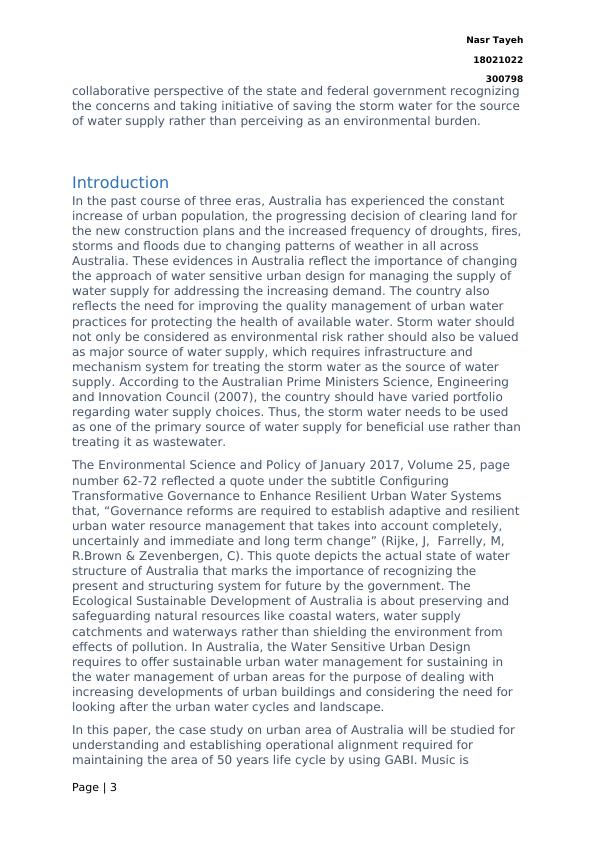
Nasr Tayeh
18021022
300798
considered to be a form of computer programme that will be utilized for
depicting total runoff, which is generated through the area along with the
calculation of water balance.
For discovering innovative procedures and methods for the improvement
of water sensitive urban design structural systems and procedures, the
outcome from these models will be utilized. The estimation of the
operational and embodied energies for the small urban areas needs to be
utilized for discovering different ways of implementing clean energy
procedures in the new future developments of construction and procedure
of reducing the currently used energy, which is used for urban area.
Designing on small scale has the potential of resolving concerns of large
scale.
The Outcomes of the Built Environment
Natural environment has experienced pressure from built
environment, which influences lives of the residents; the
pressure is created because of utilizing energy resources and
water and for land clearing activities.
Increasing population growth is another pressure that have
negative and impact over the quality of natural environment and
on liveability of the built environment of Australia.
One of the critical challenges for the built environment is climate
change, as it has caused floods, heatwaves, storms and fires in
Australia in the recent years. Due to climate change, standard
maximum temperatures are presumed to rise with the sea levels.
These situations can be a great challenge for the population in
Australia who are residing close to coasts.
The pressure impacting the efficiency and liveability of
environment will differ based on the population size and
geographical location, as majority of the population of Australia
are living near the major cities. Due to this it is presumed that
the amenities like quality and availability of water will be affected
by the pressure. Population growth will exert pressure on the
traffic congestion and housing availability.
The practices involved in built environment absorb the important
range of natural resources, thus increasing the emission of
carbon.
Due to the lack of integration and coordination between the
levels of the Australian Government, the urban planning decision
is partially effective.Innovative Techniques to Harvest and Preserve Energy
Sealing and the Air Tightness
Page | 4
18021022
300798
considered to be a form of computer programme that will be utilized for
depicting total runoff, which is generated through the area along with the
calculation of water balance.
For discovering innovative procedures and methods for the improvement
of water sensitive urban design structural systems and procedures, the
outcome from these models will be utilized. The estimation of the
operational and embodied energies for the small urban areas needs to be
utilized for discovering different ways of implementing clean energy
procedures in the new future developments of construction and procedure
of reducing the currently used energy, which is used for urban area.
Designing on small scale has the potential of resolving concerns of large
scale.
The Outcomes of the Built Environment
Natural environment has experienced pressure from built
environment, which influences lives of the residents; the
pressure is created because of utilizing energy resources and
water and for land clearing activities.
Increasing population growth is another pressure that have
negative and impact over the quality of natural environment and
on liveability of the built environment of Australia.
One of the critical challenges for the built environment is climate
change, as it has caused floods, heatwaves, storms and fires in
Australia in the recent years. Due to climate change, standard
maximum temperatures are presumed to rise with the sea levels.
These situations can be a great challenge for the population in
Australia who are residing close to coasts.
The pressure impacting the efficiency and liveability of
environment will differ based on the population size and
geographical location, as majority of the population of Australia
are living near the major cities. Due to this it is presumed that
the amenities like quality and availability of water will be affected
by the pressure. Population growth will exert pressure on the
traffic congestion and housing availability.
The practices involved in built environment absorb the important
range of natural resources, thus increasing the emission of
carbon.
Due to the lack of integration and coordination between the
levels of the Australian Government, the urban planning decision
is partially effective.Innovative Techniques to Harvest and Preserve Energy
Sealing and the Air Tightness
Page | 4
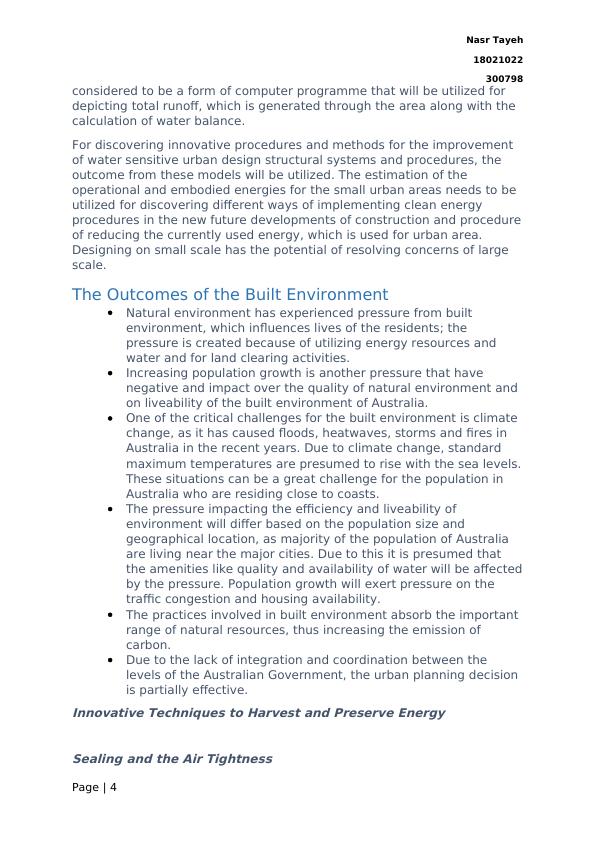
Nasr Tayeh
18021022
300798
The method of sealing and manner of Air Tightness helps in facilitating
depressurizing and pressurizing with the help of a fan on building interior
for identifying rate of the air leakage by constructing the envelope under
negative and positive pressure. The method is popular in Europe and is
used in building codes for measuring and controlling additional burden of
energy on the buildings through cooling and heating load resulting from
infiltration. This method is utilized voluntarily in Australia. The country is
recommended to adopted the method compulsorily in building code
because it will help in reducing the energy consumption. According to
Luther (2007), “Our buildings are considered leaky, two to four times
leakier than Europe and North America”. The state of water leakage in
Australian buildings is indicated though this statement.Prospective advantages of Tighter Buildings
Capital Savings- It reduces the demand of energy for cooling and
heating and reduces the size of the required mechanical equipment.
Operating savings- Energy can be saved by reducing the volume of
exfiltrated air and infiltrated air.
Condensation- It is a method for minimizing the interstitial
condensation and moisture deposition in envelope.
Control- It helps in discarding interference along with HVAC
mechanical control system.
Air Quality- The process of restricting the external pollutants and
ingress can help in improving the air quality of indoors.
Noise- Reducing the nuisance of external noise
Quality of the construction system- By concentrating on the air-
tightness details, the constriction quality can be improved.
Comfort- Improving the thermal comfort by lower cold draughts
For the purpose of saving energy, the procedure mentioned above can be
implemented for buildings, which is affordable and simple.Glowing in dark trees
The application of biomimicry technology stimulates self-sustaining and
self-sufficient form of streetlights instead of using electricity-based
streetlights in the urban regions. This technique can be executed by the
method of employing luminescent bacteria from marine species and
implementing in urban flora. This process will be treated as green
technique of minimizing the requirement for electricity.Foot traffic electricity
Foot traffic electricity can be used for replacing the traditional source of
traffic light as it accomplished by the installation of springy tiles, which
are perceptive to flex and movement underfoot. This technique employs
Page | 5
18021022
300798
The method of sealing and manner of Air Tightness helps in facilitating
depressurizing and pressurizing with the help of a fan on building interior
for identifying rate of the air leakage by constructing the envelope under
negative and positive pressure. The method is popular in Europe and is
used in building codes for measuring and controlling additional burden of
energy on the buildings through cooling and heating load resulting from
infiltration. This method is utilized voluntarily in Australia. The country is
recommended to adopted the method compulsorily in building code
because it will help in reducing the energy consumption. According to
Luther (2007), “Our buildings are considered leaky, two to four times
leakier than Europe and North America”. The state of water leakage in
Australian buildings is indicated though this statement.Prospective advantages of Tighter Buildings
Capital Savings- It reduces the demand of energy for cooling and
heating and reduces the size of the required mechanical equipment.
Operating savings- Energy can be saved by reducing the volume of
exfiltrated air and infiltrated air.
Condensation- It is a method for minimizing the interstitial
condensation and moisture deposition in envelope.
Control- It helps in discarding interference along with HVAC
mechanical control system.
Air Quality- The process of restricting the external pollutants and
ingress can help in improving the air quality of indoors.
Noise- Reducing the nuisance of external noise
Quality of the construction system- By concentrating on the air-
tightness details, the constriction quality can be improved.
Comfort- Improving the thermal comfort by lower cold draughts
For the purpose of saving energy, the procedure mentioned above can be
implemented for buildings, which is affordable and simple.Glowing in dark trees
The application of biomimicry technology stimulates self-sustaining and
self-sufficient form of streetlights instead of using electricity-based
streetlights in the urban regions. This technique can be executed by the
method of employing luminescent bacteria from marine species and
implementing in urban flora. This process will be treated as green
technique of minimizing the requirement for electricity.Foot traffic electricity
Foot traffic electricity can be used for replacing the traditional source of
traffic light as it accomplished by the installation of springy tiles, which
are perceptive to flex and movement underfoot. This technique employs
Page | 5
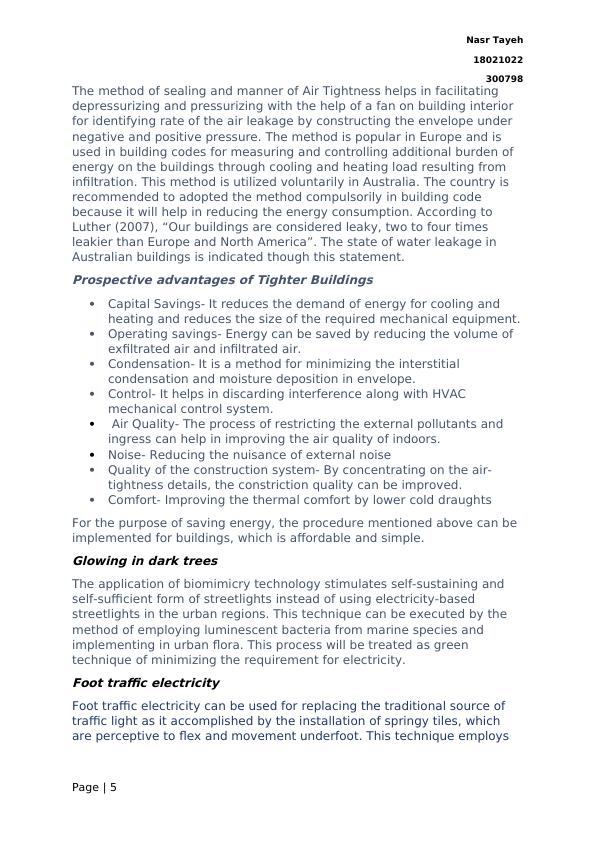
Nasr Tayeh
18021022
300798
kinetic energy for generating electricity. This method is an innovative
process of using renewable energy source.Co-heating Co-cooling, CO2 Capture
The co-generating techniques help in boosting the efficiency of energy
through applying waste heat rom the source of electricity, stimulating and
utilizing for heating or cooling the buildings. The process generating from
carbon dioxide can be applied for various applications.Mobility on Demand
This process is used for the traffic management by incorporating
smartphones and computer for communicating the reduction of fuel and
time waste through self-driving vehicles and sharing vehicles.
Project brief
The project will require the assessment of 10 hectares. The selected region should
be fully urbanized land in Australia. The chosen land needs complete analysis,
where it should include:
Total number of commercial and residential buildings
Constructing a standard design for residential house that adheres to BASIX
(including BASIX certification amongst appendices of the report)
GABI can be used for estimation of embodied energy in regards with
commercial and residential properties.
Estimation of operational energy that is essential in both commercial and
residential properties.
Calculation of total energy needed for sustaining urban centres for the time
period of approximately 50 years
MUSIC can be used for the estimation of total runoff, which is stimulated from
the chosen region
The data of rainfall deduced from MUSIC should be from the closest rainfall
station.
The data of rainfall can be deduced through BoM website.
Finding the WSUD technologies, which can be accepted in regards with the
chosen urban area.
Water balance needs to be stimulated for chosen urban region, which
includes outflow and inflow of water in urban centre.
Stimulating a concise summary regarding the collected data followed by
assessment
Developing convincing conclusion section followed by recommendations.
Risk and sustainability management
Page | 6
18021022
300798
kinetic energy for generating electricity. This method is an innovative
process of using renewable energy source.Co-heating Co-cooling, CO2 Capture
The co-generating techniques help in boosting the efficiency of energy
through applying waste heat rom the source of electricity, stimulating and
utilizing for heating or cooling the buildings. The process generating from
carbon dioxide can be applied for various applications.Mobility on Demand
This process is used for the traffic management by incorporating
smartphones and computer for communicating the reduction of fuel and
time waste through self-driving vehicles and sharing vehicles.
Project brief
The project will require the assessment of 10 hectares. The selected region should
be fully urbanized land in Australia. The chosen land needs complete analysis,
where it should include:
Total number of commercial and residential buildings
Constructing a standard design for residential house that adheres to BASIX
(including BASIX certification amongst appendices of the report)
GABI can be used for estimation of embodied energy in regards with
commercial and residential properties.
Estimation of operational energy that is essential in both commercial and
residential properties.
Calculation of total energy needed for sustaining urban centres for the time
period of approximately 50 years
MUSIC can be used for the estimation of total runoff, which is stimulated from
the chosen region
The data of rainfall deduced from MUSIC should be from the closest rainfall
station.
The data of rainfall can be deduced through BoM website.
Finding the WSUD technologies, which can be accepted in regards with the
chosen urban area.
Water balance needs to be stimulated for chosen urban region, which
includes outflow and inflow of water in urban centre.
Stimulating a concise summary regarding the collected data followed by
assessment
Developing convincing conclusion section followed by recommendations.
Risk and sustainability management
Page | 6

Nasr Tayeh
18021022
300798
The chosen urban are for the assessment is near the suburb of Western Sydney
Bass Hill, NSW, 2197
The area of the chosen region is 102,070.73 m3 = 10.207 Ha.
Terrain view by google
Chosen area in Australia includes a total of five street, Baird Street, a section of the Hector
Street, Broad Street and Buist Street.
Total number of buildings involving residential and commercial in
the selected region near Australia:
Page | 7
18021022
300798
The chosen urban are for the assessment is near the suburb of Western Sydney
Bass Hill, NSW, 2197
The area of the chosen region is 102,070.73 m3 = 10.207 Ha.
Terrain view by google
Chosen area in Australia includes a total of five street, Baird Street, a section of the Hector
Street, Broad Street and Buist Street.
Total number of buildings involving residential and commercial in
the selected region near Australia:
Page | 7
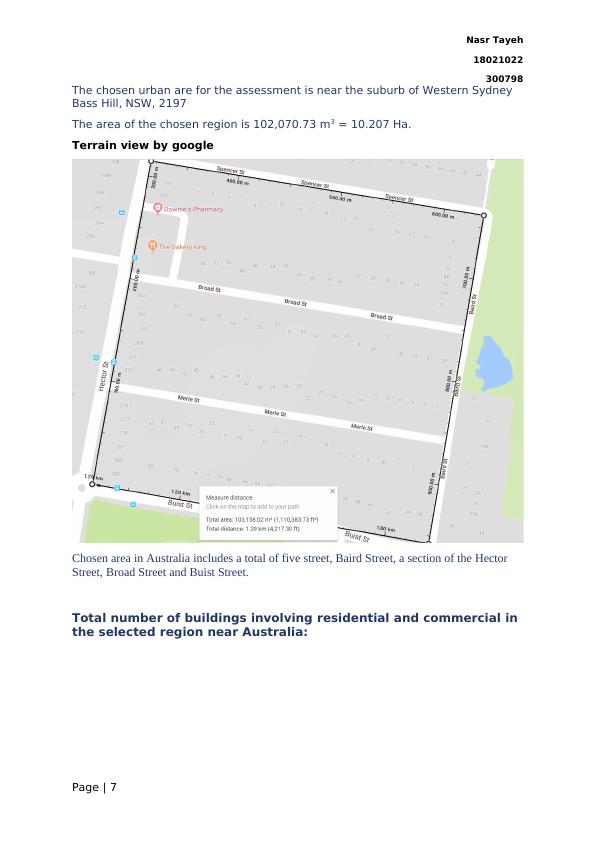
Nasr Tayeh
18021022
300798
The depiction of total houses in the area between the Buist Street to Merle Street
is 35 and the presence of 13 buildings.
There are a total of forty houses and nine buildings in the area between Broad
Street and Merle Street.
Page | 8
18021022
300798
The depiction of total houses in the area between the Buist Street to Merle Street
is 35 and the presence of 13 buildings.
There are a total of forty houses and nine buildings in the area between Broad
Street and Merle Street.
Page | 8
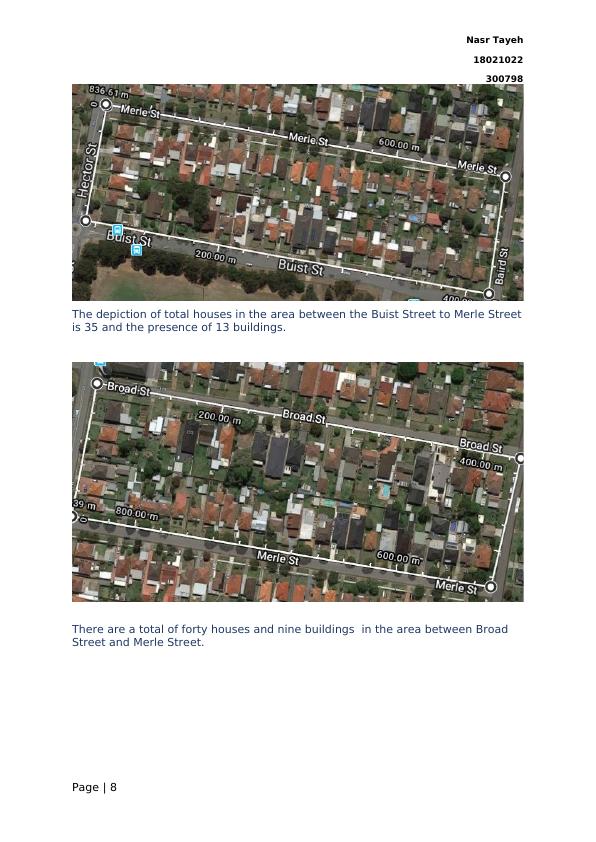
End of preview
Want to access all the pages? Upload your documents or become a member.
Related Documents
Sustainability and Risk Engineeringlg...
|34
|5415
|201
Global Politics Assignment | Energy and Environmentlg...
|18
|4690
|121
Effects of Global Warming on Energy Use in Buildinglg...
|11
|2344
|42
Geography | Sustainable Systems | Assignmentlg...
|12
|3185
|17
Engineering Practice | Civil Engineeringlg...
|8
|1875
|18
Sustainable Energy Assignment Samplelg...
|21
|5900
|31
